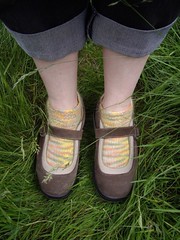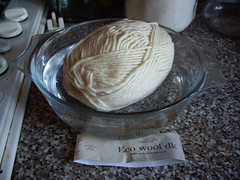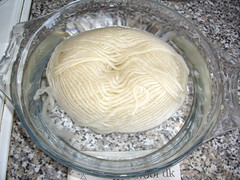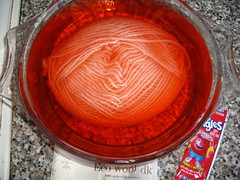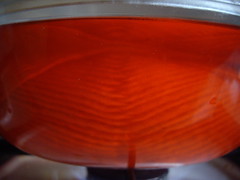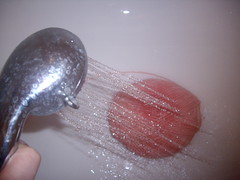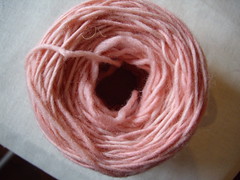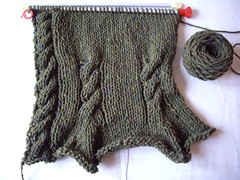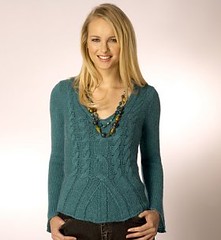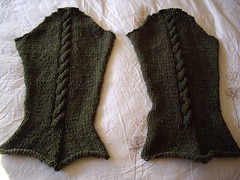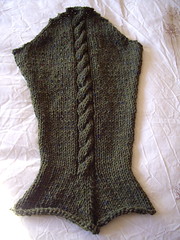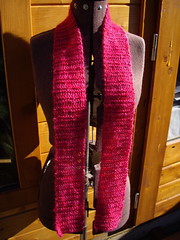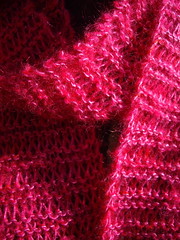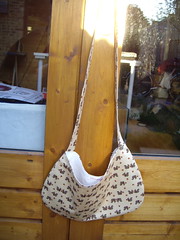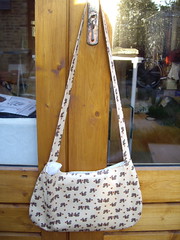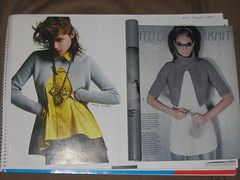The Dreaded Lurgy keeps striking me down in sudden and annoying ways, so I have mostly spent the weekend quietly knitting.
The first part of the weekend was spent unravelling, when I realised that I couldn’t bear to knit another stitch on the Cardigan with Cabled Points, and I was no longer certain that I actually wanted to wear it even if I did force myself to get it finished. So, I made the executive decision to unravel the whole thing.
I still wanted to knit a zip-fronted cardigan, but I decided to go for something a lot simpler. No pointy bits, no cabling on rows that didn’t line up, just a simple fitted cardigan.
Having turned to Ann Budd for help, I managed to get this far:
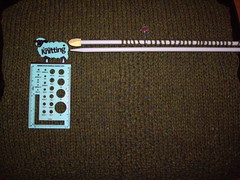
I’ve typed the pattern out below, for a size 36″ chest. Once the cardigan’s finished, I’ll write out the pattern in more sizes and make it available, probably as a PDF file. It should work with any chunky weight wool.
I haven’t checked the pattern for any glaring errors yet, mostly because I haven’t finished knitting it! I’ll make edits as I go along, if I find anything that’s difficult to follow.
If you decide to follow the pattern and find anything odd about it, please let me know!
Moss Stitch Trim Zip-Up Cardigan
Wool used – RowanSpun Chunky, approximately 525 metres.
Any chunky weight yarn should work out fine, as long as the gauge is correct.
7.5mm straight needles.
12 stitches and 18 rows to 4 inches.
The pattern below is for a finished chest measurement of 36″.
Back
Cast on 54 sts
Moss stitch for 10 rows
St st until piece measures 6″
Dec 1 st at each end of next and foll alt row*
Work 5 rows even
Inc 1 st at each end of next and foll alt row
Work even until piece measures 13″
Armhole Shaping
Cast off 3 sts at beg of next 2 rows
Cast off 2 sts at beg of next 2 rows
Dec 1 st at each end of next and foll alt row
Work even on 40 sts until armhole measures 8½”
Shoulder Shaping
Cast off 5 sts at beg of next 4 rows
Cast off rem 20 sts for back neck
Left Front
Cast on 27 sts
Moss stitch for 10 rows
Change to st st, keeping 6 sts in moss stitch at end of all rows. (This creates self band.)
St st until piece measures 6″
Dec 1 st at beg of next and foll alt row*
Work 5 rows even
Inc 1 st at beg of next and foll alt row
Work even until piece measures 13″, ending on ws row.
Armhole Shaping
Cast off 3 sts at beg of next row
Cast off 2 sts at beg of foll rs row
Dec 1 st at beg of each rs row, 2 times
Work even on 20 sts until armhole measures 7″, ending with ws row
Neck Shaping
Slip 6 edge sts onto stitch holder
Join new yarn, and work to end of row
At beg of next ws row, cast off 5 sts
Cast off 1 st at beg of next rs row (neck edge), 2 times
Then dec 1 st at neck edge every rs row, 3 times
Cont even on 4 sts until piece measures same as back, ending with ws row.
Shoulder Shaping
Cast off 4 sts.
Right Front
Cast on 27 sts
Moss stitch for 10 rows
Change to st st, keeping 6 sts in moss stitch at beginning of all rows. (This creates self band.)
St st until piece measures 6″
Dec 1 st at end of next and foll alt row*
Work 5 rows even
Inc 1 st at end of next and foll alt row
Work even until piece measures 13″, ending on rs row.
Armhole Shaping
Cast off 3 sts at beg of next row
Cast off 2 sts at beg of foll ws row
Dec 1 st at beg of each ws row, 2 times
Work even on 20 sts until armhole measures 7″, ending on rs row
Neck Shaping
Work to last 6 sts.
Slip 6 edge sts on to stitch holder.
At beg of next rs row, cast off 5 sts
Cast off 1 st at beg of next ws row (neck edge), 2 times
Then dec 1 st at neck edge every ws row, 3 times
Cont even on 4 sts until piece measures same as back, ending with ws row.
Shoulder Shaping
Cast off 4 sts.
Neck Band
Sew fronts to back at shoulder seams
Mark centre back
Work on 6 sts of each front band in moss stitch until they are long enough to meet at centre back
Cast off and sew bands together at centre back, or graft bands together
Sew bands to fronts and back neck.
Sleeves
Cast on 28 sts
Moss stitch for 10 rows
Change to st st
Inc 1 st at each end of every 6 rows, 9 times
Work even on 46 sts until piece measures 16″ (or desired length to armhole)
Shape Cap
Cast off 3 sts at beg of next 2 rows
Cast off 2 sts at beg of next 2 rows
Dec 1 st at each end of every rs row, 2 times (32 sts)
Dec 1 st at each end every 4 rows
Dec 1 st at each end of every rs row, 6 times
Cast off 4 sts at beg of next 2 rows
Cast off rem 10 sts
Finishing
Block all pieces, if necessary
Sew fronts to back at side seams
Sew sleeve seams
Set sleeves into armholes
Insert zip at centre front.
Notes
*If you do not require waist shaping, simply leave these rows out, and work even until piece measures 13″.
As you knit the fronts, you may find that the moss stitch pulls the work upwards. you can gently stretch the bands out as you go, or you can leave it, and even things out when you block.
When you knit the bands, you may find that you need to knit them longer than you think, in order to stretch them around the curves of the crew neck.
Like this:
Like Loading...

